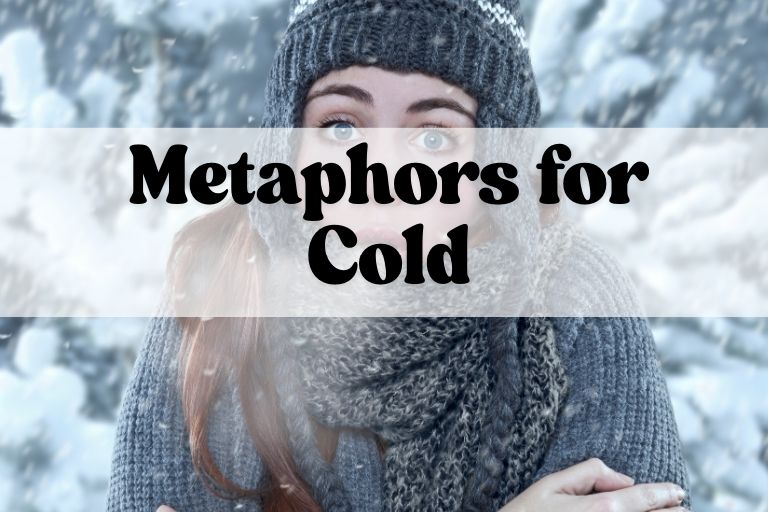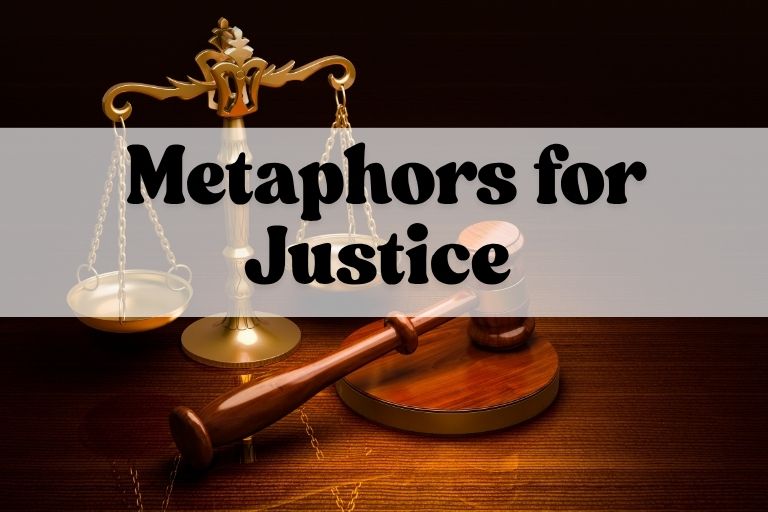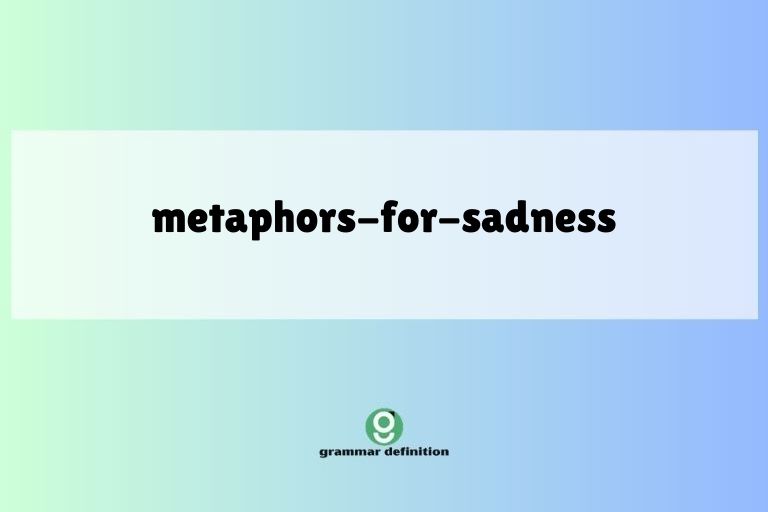Icy Tongues: Mastering Metaphors for Cold in English

Understanding how to use metaphors effectively is crucial for adding depth and vividness to your writing and speech. Metaphors allow us to draw connections between seemingly unrelated concepts, creating powerful imagery and conveying complex emotions in a concise way.
This article focuses on exploring metaphors for “cold,” a sensation that evokes a range of feelings from discomfort to danger. By mastering these metaphors, English learners can enhance their expressive abilities and gain a more nuanced understanding of the language.
This guide is perfect for intermediate to advanced English learners, writers, and anyone looking to enrich their vocabulary and descriptive skills.
This article will delve into defining metaphors, exploring their structural elements, and categorizing different types of cold-related metaphors. Through numerous examples, practice exercises, and explanations of common mistakes, you’ll learn how to use these metaphors accurately and effectively.
Additionally, we’ll cover advanced topics and address frequently asked questions to provide a comprehensive understanding of this fascinating aspect of English grammar.
Table of Contents
- Definition of Metaphor
- Structural Breakdown of Cold Metaphors
- Types and Categories of Cold Metaphors
- Examples of Cold Metaphors
- Usage Rules for Cold Metaphors
- Common Mistakes with Cold Metaphors
- Practice Exercises
- Advanced Topics in Cold Metaphors
- Frequently Asked Questions
- Conclusion
Definition of Metaphor
A metaphor is a figure of speech that directly compares two unrelated things, asserting that one thing *is* another, not just that it is *like* another (which would be a simile). The purpose of a metaphor is to create a vivid image or convey a deeper meaning by transferring qualities from one concept to another.
Metaphors enrich language by adding layers of meaning and encouraging the audience to see familiar things in a new light.
In the context of “cold,” metaphors extend beyond the literal sensation of low temperature. They can describe emotional states, personality traits, or even social situations.
Understanding the different ways “cold” can be used metaphorically allows for more nuanced and expressive communication.
Structural Breakdown of Cold Metaphors
The structure of a metaphor typically involves two key elements: the tenor and the vehicle. The tenor is the subject to which metaphorical attributes are ascribed, while the vehicle is the object or concept whose attributes are borrowed. In metaphors for “cold,” the tenor can be a person, a situation, or an emotion, and the vehicle is some aspect of literal coldness.
For example, in the metaphor “He gave me a frosty look,” the tenor is “his look,” and the vehicle is “frosty.” The metaphor suggests that his look possessed the qualities of frost, such as being unwelcoming and distant.
Effective cold metaphors often rely on sensory details associated with coldness, such as numbness, sharpness, or the feeling of being isolated. By invoking these sensations, the metaphor gains impact and resonates more strongly with the audience.
Types and Categories of Cold Metaphors
Cold metaphors can be categorized based on the specific aspect of coldness they emphasize. These categories help to understand the different ways “cold” can be used to describe various concepts.
Physical Sensations
These metaphors relate to the direct physical experience of coldness. They describe how something feels as if it were physically cold, such as numb, sharp, or biting.
These metaphors often evoke a sense of discomfort or pain.
Emotional States
Emotional coldness refers to a lack of warmth, empathy, or affection. These metaphors describe individuals or situations characterized by detachment, indifference, or cruelty.
Examples include “a cold heart” or “a chilling silence.”
Environmental Conditions
These metaphors use cold weather conditions to describe situations or environments that are harsh, unforgiving, or isolating. Examples include “a frozen economy” or “a bleak landscape.”
Behavioral Traits
Behavioral metaphors describe actions or behaviors that are considered cold, such as being calculating, unemotional, or ruthless. Examples include “a cold decision” or “a frosty reception.”
Examples of Cold Metaphors
The following sections provide detailed examples of cold metaphors, categorized by the types discussed above. Each example is designed to illustrate how “cold” can be used to describe different aspects of human experience.
Physical Cold Metaphors
Physical cold metaphors describe the direct sensation of cold. The following table provides examples of these metaphors in various contexts.
| Metaphor | Context | Explanation |
|---|---|---|
| “A glacial pace” | Describing progress on a project | Compares the slow progress to the movement of a glacier. |
| “A frosty reception” | Describing how someone was greeted | Suggests the greeting was unwelcoming and unfriendly. |
| “His words were icy“ | Describing someone’s tone of voice | Implies the person’s words were harsh and cutting. |
| “A freezing wind” | Describing the weather | Emphasizes the intense coldness of the wind. |
| “Chilled to the bone” | Describing how cold someone feels | Indicates extreme coldness that penetrates deeply. |
| “The news sent a cold shiver down my spine” | Describing a reaction to bad news | Suggests the news was frightening or unsettling. |
| “Her touch was frigid“ | Describing someone’s physical contact | Implies the person’s touch was cold and unwelcoming. |
| “A biting wind” | Describing the sharpness of the wind | Suggests the wind is harsh and painful. |
| “The room was arctic“ | Describing the temperature of a room | Implies the room was extremely cold, like the Arctic. |
| “His stare was frozen“ | Describing someone’s gaze | Suggests the person’s stare was fixed and emotionless. |
| “A wintry mix” | Describing precipitation | Indicates a combination of snow, sleet, and freezing rain. |
| “The air felt crisp and cold” | Describing the quality of the air | Suggests the air was refreshing but also cold. |
| “He felt a cold sweat” | Describing a physical reaction to fear | Indicates nervousness or anxiety. |
| “The water was ice-cold“ | Describing the temperature of water | Emphasizes the extreme coldness of the water. |
| “Numb with cold” | Describing a loss of sensation | Implies the cold has caused a loss of feeling. |
| “A cold draft” | Describing a current of air | Suggests the air current is unpleasantly cold. |
| “The metal was icy to the touch” | Describing the temperature of a surface | Implies the surface is extremely cold. |
| “She gave him a glacial smile” | Describing someone’s smile | Suggests the smile was insincere and cold. |
| “He spoke in a frosty tone” | Describing someone’s tone of voice | Implies the person’s tone was unfriendly and unwelcoming. |
| “The wind was bitterly cold“ | Describing the intensity of the cold | Emphasizes the extreme and unpleasant coldness of the wind. |
| “His hands were like ice“ | Describing someone’s cold hands | Indicates the person’s hands were extremely cold. |
| “The room had a chilly atmosphere” | Describing the feeling of a room | Suggests the room felt cold and unwelcoming. |
| “A cold shower” | Describing a literal cold shower | Can also mean a disappointment or setback. |
Emotional Cold Metaphors
Emotional cold metaphors describe a lack of warmth or empathy. The following table provides examples of these metaphors in various contexts.
| Metaphor | Context | Explanation |
|---|---|---|
| “A cold heart” | Describing someone’s lack of empathy | Implies the person is unfeeling and unsympathetic. |
| “A frozen smile” | Describing an insincere expression | Suggests the smile is forced and lacks genuine warmth. |
| “An icy stare” | Describing a hostile gaze | Implies the person’s gaze is unfriendly and unwelcoming. |
| “A chilling silence” | Describing an awkward or tense moment | Suggests the silence is uncomfortable and unsettling. |
| “A frigid relationship” | Describing a distant or loveless relationship | Implies the relationship lacks warmth and affection. |
| “His words were cold and cutting” | Describing harsh criticism | Indicates the person’s words were cruel and hurtful. |
| “She gave him a glacial look” | Describing a disapproving expression | Suggests the look was cold and unwelcoming. |
| “A wintry demeanor” | Describing someone’s personality | Implies the person is cold and unfriendly. |
| “He felt a coldness in her voice” | Describing a lack of emotion | Indicates the person’s voice lacked warmth and feeling. |
| “A heart of ice“ | Describing someone cruel | Emphasizes the person’s lack of compassion. |
| “The news left her cold“ | Describing a lack of reaction | Suggests the person was unaffected by the news. |
| “A cold shoulder” | Describing being ignored | Indicates someone is being deliberately ignored or snubbed. |
| “He gave a cold response” | Describing an unemotional reply | Implies the person’s response lacked warmth and empathy. |
| “A cold farewell” | Describing an unemotional goodbye | Suggests the goodbye lacked warmth and affection. |
| “She had a cold personality” | Describing someone’s character | Implies the person is unemotional and distant. |
| “A cold calculation” | Describing a ruthless decision | Suggests the decision was made without emotion or empathy. |
| “A cold revenge” | Describing a calculated act of vengeance | Implies the revenge was planned and executed without emotion. |
| “He had a cold disregard for others” | Describing a lack of concern for others | Indicates the person is indifferent to the feelings of others. |
| “Her eyes were cold and distant” | Describing someone’s expression | Suggests the person’s eyes lacked warmth and emotion. |
| “A cold atmosphere” | Describing a tense environment | Implies the environment is unfriendly and unwelcoming. |
| “He felt a cold dread” | Describing a feeling of fear | Suggests the fear is intense and unsettling. |
| “A cold comfort” | Describing an unhelpful consolation | Implies the comfort offered is inadequate and unemotional. |
| “She offered a cold apology” | Describing an insincere apology | Suggests the apology lacked genuine remorse. |
Environmental Cold Metaphors
Environmental cold metaphors use cold weather conditions to describe situations or environments. The following table provides examples of these metaphors in various contexts.
| Metaphor | Context | Explanation |
|---|---|---|
| “A frozen economy” | Describing a stagnant economy | Implies the economy is not growing or developing. |
| “A bleak landscape” | Describing a desolate environment | Suggests the environment is barren and unwelcoming. |
| “A wintry silence” | Describing a quiet and empty place | Implies the place is desolate and lifeless. |
| “A cold war” | Describing a state of political tension | Suggests the tension is constant and unresolved. |
| “A frozen conflict” | Describing an unresolved dispute | Implies the conflict is stagnant and unlikely to be resolved. |
| “A cold climate for innovation” | Describing a discouraging environment | Indicates the environment is not conducive to new ideas. |
| “A frozen asset” | Describing an inaccessible resource | Implies the resource is unavailable for use. |
| “A cold case” | Describing an unsolved crime | Suggests the case is unlikely to be solved due to lack of evidence. |
| “A bleak outlook” | Describing a pessimistic forecast | Implies the future is uncertain and unfavorable. |
| “A frozen budget” | Describing a stagnant financial plan | Suggests the budget is not being adjusted or increased. |
| “A cold reception in the market” | Describing a poor product launch | Indicates the product was not well-received by consumers. |
| “The project hit a cold patch” | Describing a difficult phase | Suggests the project encountered unexpected challenges. |
| “A cold environment for investment” | Describing a discouraging market | Implies the market is not favorable for investors. |
| “A frozen account” | Describing an inaccessible bank account | Suggests the account is blocked or restricted. |
| “A cold political landscape” | Describing a tense political situation | Implies the political environment is unfriendly and divided. |
| “The industry is in a cold slump” | Describing a period of economic downturn | Suggests the industry is experiencing a decline. |
| “A frozen job market” | Describing a lack of employment opportunities | Implies there are few available jobs. |
| “The company received a cold assessment” | Describing a negative evaluation | Suggests the company’s performance was judged unfavorably. |
| “A cold regulatory climate” | Describing a strict legal environment | Implies the regulations are restrictive and unfavorable. |
| “The negotiations reached a cold stalemate” | Describing a deadlocked discussion | Suggests the negotiations are stuck and unlikely to progress. |
| “A cold reception from critics” | Describing a negative review | Suggests the work was not well-received by critics. |
| “The team faced a cold reality” | Describing a harsh truth | Implies the reality was difficult and unforgiving. |
| “The merger had a cold start” | Describing a difficult beginning | Suggests the merger faced initial challenges. |
Behavioral Cold Metaphors
Behavioral metaphors describe actions or behaviors that are considered cold. The following table provides examples of these metaphors in various contexts.
| Metaphor | Context | Explanation |
|---|---|---|
| “A cold decision” | Describing a calculated choice | Implies the decision was made without emotion. |
| “A frosty dismissal” | Describing an unfriendly termination | Suggests the dismissal was harsh and unwelcoming. |
| “An icy response” | Describing an unemotional reaction | Implies the response lacked warmth and empathy. |
| “A chilling warning” | Describing a threatening message | Suggests the warning was frightening and unsettling. |
| “A frigid refusal” | Describing a cold rejection | Implies the refusal was harsh and unyielding. |
| “He gave a cold assessment” | Describing an unemotional evaluation | Indicates the assessment lacked personal consideration. |
| “She offered a glacial apology” | Describing an insincere regret | Suggests the apology lacked genuine remorse. |
| “A wintry negotiation” | Describing a difficult discussion | Implies the negotiation was tense and unfriendly. |
| “He handled the situation with cold precision” | Describing an unemotional approach | Indicates the person acted without emotion or empathy. |
| “A cold strategy” | Describing a calculated plan | Suggests the plan was developed without emotional considerations. |
| “He delivered a cold speech” | Describing an unemotional address | Implies the speech lacked warmth and personal connection. |
| “She made a cold calculation” | Describing a ruthless decision | Indicates the decision was made without emotion or empathy. |
| “He offered a cold compromise” | Describing an unemotional agreement | Suggests the compromise lacked genuine willingness to concede. |
| “She presented a cold argument” | Describing an unemotional case | Implies the argument lacked warmth and personal connection. |
| “He executed the plan with cold efficiency” | Describing an unemotional execution | Indicates the plan was carried out without emotion or empathy. |
| “She gave a cold explanation” | Describing an unemotional account | Suggests the explanation lacked warmth and personal connection. |
| “He approached the problem with cold logic” | Describing an unemotional analysis | Implies the analysis was based solely on logic, without emotion. |
| “She handled the crisis with cold control” | Describing an unemotional response | Indicates the person remained calm and unemotional during the crisis. |
| “He offered a cold suggestion” | Describing an unemotional idea | Suggests the suggestion lacked warmth and personal connection. |
| “She delivered a cold verdict” | Describing an unemotional judgment | Implies the verdict lacked warmth and personal consideration. |
| “He implemented a cold policy” | Describing an unemotional rule | Suggests the policy lacked warmth and personal connection. |
| “She provided a cold analysis” | Describing an unemotional examination | Implies the analysis lacked warmth and personal insight. |
| “He presented a cold proposal” | Describing an unemotional offer | Suggests the proposal lacked warmth and personal consideration. |
Usage Rules for Cold Metaphors
Using cold metaphors effectively requires attention to context and audience. It’s important to ensure that the metaphor resonates with the intended meaning and doesn’t create unintended connotations.
Some general rules include:
- Contextual Appropriateness: Ensure the metaphor fits the tone and subject matter.
- Audience Awareness: Consider how the audience will interpret the metaphor.
- Consistency: Maintain consistency in the metaphor throughout the text.
- Originality: Strive for fresh and creative metaphors to avoid clichés.
Common Mistakes with Cold Metaphors
One common mistake is using clichés, such as “cold as ice,” without adding any original thought. Another mistake is misusing metaphors in a way that creates confusion or doesn’t align with the intended meaning.
Here are some examples of common mistakes and corrections:
| Incorrect | Correct | Explanation |
|---|---|---|
| “He was cold as ice.” | “His heart was a frozen tundra.” | Replaces a cliché with a more vivid and original metaphor. |
| “The economy is freezing hot.” | “The economy is in deep freeze.” | Corrects a contradictory metaphor to accurately convey the intended meaning. |
| “Her words were like a chilly breeze.” | “Her words were a frosty blast.” | Strengthens the metaphor by using a more impactful comparison. |
| “He gave me a cold welcome.” | “He gave me a frosty reception.” | Choose a more apt metaphor to describe the welcome. |
| “The silence was cold like an ice.” | “The silence was a chilling frost.” | Use a more accurate metaphor. |
Practice Exercises
Test your understanding of cold metaphors with the following exercises. Identify the type of cold metaphor used in each sentence and provide an explanation of its meaning.
| Question | Answer |
|---|---|
| 1. Her response to the proposal was icy. | Emotional: Her response lacked warmth and enthusiasm. |
| 2. The economic climate is frozen. | Environmental: The economy is stagnant and not growing. |
| 3. He made a cold calculation. | Behavioral: He made a decision without emotion or empathy. |
| 4. The wind was biting. | Physical: The wind was harsh and painful. |
| 5. She gave him the cold shoulder. | Emotional: She deliberately ignored him. |
| 6. The news sent a cold shiver down her spine. | Physical: The news was frightening or unsettling. |
| 7. The project hit a cold patch. | Environmental: The project encountered unexpected challenges. |
| 8. He had a heart of ice. | Emotional: He was cruel and lacked compassion. |
| 9. The room was arctic. | Physical: The room was extremely cold. |
| 10. Her touch was frigid. | Physical: Her touch was cold and unwelcoming. |
Exercise 2: Fill in the blanks with an appropriate cold metaphor:
| Question | Answer |
|---|---|
| 1. The ______ silence made everyone uncomfortable. | chilling |
| 2. The economy is in a ______, with little sign of recovery. | deep freeze |
| 3. He made a ______ decision, ignoring the human cost. | cold |
| 4. The ______ wind cut through our coats. | biting |
| 5. She gave him the _______ after the argument. | cold shoulder |
| 6. The _______ atmosphere of the meeting made it difficult to collaborate. | frigid |
| 7. The _______ landscape offered no shelter from the storm. | bleak |
| 8. His _______ stare sent a shiver down her spine. | icy |
| 9. The _______ reception made us feel unwelcome. | frosty |
| 10. The _______ news left her unmoved. | cold |
Exercise 3: Rewrite the following sentences using a cold metaphor:
| Question | Answer |
|---|---|
| 1. The negotiations were unproductive. | The negotiations reached a frozen stalemate. |
| 2. She ignored his attempts to reconcile. | She gave him the cold shoulder. |
| 3. The team was not enthusiastic about the new project. | The team gave the new project a frosty reception. |
| 4. His words were harsh and unkind. | His words were icy and cutting. |
| 5. The atmosphere in the room was tense and uncomfortable. | The atmosphere in the room was chilling. |
| 6. The economic situation is stagnant. | The economic situation is frozen. |
| 7. He made a decision without considering emotions. | He made a cold decision. |
| 8. The wind was extremely cold and painful. | The wind was biting. |
| 9. She was unmoved by the sad story. | The sad story left her cold. |
| 10. The room was very cold. | The room was arctic. |
Advanced Topics in Cold Metaphors
For advanced learners, exploring the cultural and historical context of cold metaphors can provide deeper insights. Different cultures may associate different meanings with coldness, influencing the way metaphors are used.
For example, in some cultures, coldness may be associated with purity or clarity, while in others, it may be solely associated with negativity.
Additionally, analyzing the use of cold metaphors in literature and poetry can reveal sophisticated techniques for conveying complex emotions and ideas. Authors often use cold metaphors to create a sense of foreboding, isolation, or emotional detachment.
Frequently Asked Questions
Here are some frequently asked questions about cold metaphors:
- What is the difference between a metaphor and a simile?
A metaphor directly equates two things (e.g., “Her heart was ice”), while a simile uses “like” or “as” to make a comparison (e.g., “Her heart was like ice”). Metaphors are stronger and more direct, while similes are more tentative.
- How can I avoid using clichés in my metaphors?
Focus on creating original connections between ideas. Think about the specific qualities of coldness you want to convey and find unique ways to express them. Use vivid imagery and sensory details to make your metaphors more impactful.
- Can a metaphor be too complex?
Yes, a metaphor should be understandable to your audience. If a metaphor is too abstract or obscure, it may confuse readers or listeners rather than enhance their understanding. Strive for clarity and relevance in your metaphorical language.
- How do I choose the right cold metaphor for a particular situation?
Consider the specific emotion or idea you want to convey. Think about the different aspects of coldness—such as sharpness, numbness, or isolation—and choose a metaphor that aligns with your intended meaning. Also, consider your audience and the context in which you are speaking or writing.
- Are cold metaphors always negative?
While cold metaphors often have negative connotations (e.g., “a cold heart”), they can also be used in a neutral or even positive way, depending on the context. For example, “a cold analysis” might suggest objectivity and lack of bias.
- How can I improve my ability to create effective metaphors?
Read widely and pay attention to how authors use metaphorical language. Practice creating your own metaphors by brainstorming different ways to describe familiar concepts. Get feedback from others on the effectiveness of your metaphors.
- What role does culture play in the interpretation of cold metaphors?
Cultural background can significantly influence how metaphors are understood. Different cultures may have different associations with coldness, affecting the emotional and symbolic meaning of the metaphor. Being aware of these cultural nuances can help you use metaphors more effectively.
- How can I use cold metaphors in creative writing?
Cold metaphors can add depth and texture to your writing by evoking strong sensory images and emotional responses. Experiment with different types of cold metaphors to create a desired mood or atmosphere. Use metaphors to reveal character traits, describe settings, or explore thematic ideas.
Conclusion
Mastering metaphors for “cold” is a valuable skill for anyone looking to enhance their English language proficiency. By understanding the different types of cold metaphors and how to use them effectively, you can add depth, nuance, and vividness to your communication.
Pay attention to context, audience, and cultural considerations to ensure your metaphors resonate with the intended meaning.
Continue to practice using cold metaphors in your writing and speaking, and seek feedback from others to refine your skills. With dedication and attention to detail, you can unlock the power of metaphorical language and express yourself with greater clarity and creativity.
Remember that the key to effective metaphor usage is understanding the underlying connections between seemingly unrelated concepts and finding fresh, original ways to express them.






